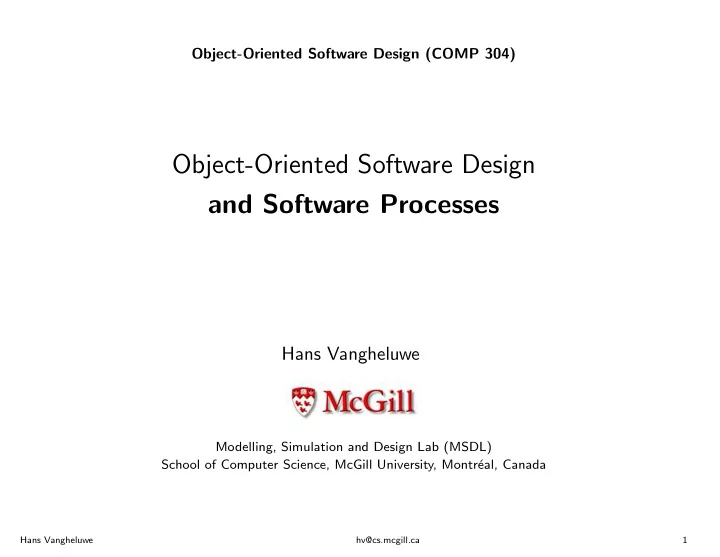

Object-Oriented Software Design (COMP 304) Object-Oriented Software Design and Software Processes Hans Vangheluwe Modelling, Simulation and Design Lab (MSDL) School of Computer Science, McGill University, Montr´ eal, Canada Hans Vangheluwe hv@cs.mcgill.ca 1
Overview 1. (Software) Process: definition 2. Various Software Processes 3. The Process Influences Productivity: Dynamic Process Modelling using Forrester System Dynamics Hans Vangheluwe hv@cs.mcgill.ca 2
Process: A Queueing System Departure Arrival Cashier Queue Physical View Departure Arrival Cashier Queue [IAT distribution] [ST distribution] Abstract View Hans Vangheluwe hv@cs.mcgill.ca 3
Event/Activity/Process Cust2 Process Cust2 Activity Cust2 Activity queue pay cashier Cust1 Process Cust1 Activity pay cashier Cust1 Arrival Cust1 End pay cashier t Cust1 Start pay cashier Cust1 Leave Cust2 Arrival Cust2 End Queueing Cust2 End pay cashier Cust2 Start Queueing Cust2 Start pay cashier Cust2 Leave Event Hans Vangheluwe hv@cs.mcgill.ca 4
Software Processes “The Software Engineering process is the total set of Software Engineering activities needed to transform requirements into software”. Watts S. Humphrey. Software Engineering Institute, CMU. ( portal.acm.org/citation.cfm?id=75122 ) Hans Vangheluwe hv@cs.mcgill.ca 5
Software Processes • Waterfall (Royce) • V Model (German Ministry of Defense) • Prototyping • Operational Specification (Zave) • Transformational (automated software synthesis) (Balzer) • Phased Development: Increment and Iteration • Spiral Model (Boehm) • Rational Unified Process (RUP) • Extreme Programming (XP) • System Dynamics (Dynamic Process Model) (see Process ∼ Productivity) Hans Vangheluwe hv@cs.mcgill.ca 6
Shari Lawrence Pfleeger. Software Engineering: Theory and Practice (Second Edition). Prentice Hall. 2001. Chapter 2: Modelling the Process and Life Cycle. Hans Vangheluwe hv@cs.mcgill.ca 7
Waterfall Process (Royce) Hans Vangheluwe hv@cs.mcgill.ca 8
Waterfall Process in Reality Hans Vangheluwe hv@cs.mcgill.ca 9
Waterfall Process with Prototyping Hans Vangheluwe hv@cs.mcgill.ca 10
V Model (German Ministry of Defense) Hans Vangheluwe hv@cs.mcgill.ca 11
Prototyping Process Hans Vangheluwe hv@cs.mcgill.ca 12
Operational Specification Process (Zave) Hans Vangheluwe hv@cs.mcgill.ca 13
Transformational Process Hans Vangheluwe hv@cs.mcgill.ca 14
Phased Development Process Hans Vangheluwe hv@cs.mcgill.ca 15
Phased Development: Incremental vs. Iterative Hans Vangheluwe hv@cs.mcgill.ca 16
Spiral Model (Boehm) Hans Vangheluwe hv@cs.mcgill.ca 17
The Rational Unified Process (RUP): Activity Workload as Function of Time Hans Vangheluwe hv@cs.mcgill.ca 18
The (Rational) Unified Process ((R)UP): Empirical Observations 1. Waterfall-like sequence of Requirements, Design, Implementation, Testing. 2. Not pure waterfall: • Phased Development ( iterative ) • Overlap ( concurrency ) between activities 3. Testing: • Regression (test not only newly developed, but also previously developed code) • Testing starts before design and coding (Extreme Programming) Hans Vangheluwe hv@cs.mcgill.ca 19
RUP: Phased Development Use: • descriptive • prescriptive • proscriptive Hans Vangheluwe hv@cs.mcgill.ca 20
Extreme Programming (XP) ( www.extremeprogramming.org ) Hans Vangheluwe hv@cs.mcgill.ca 21
Extreme Programming (XP) highlights User Stories are written by the customers as things that the system needs to do for them (requirements). They drive the creation of acceptance tests . Hans Vangheluwe hv@cs.mcgill.ca 22
Extreme Programming (XP) Process The project is divided into Iterations . The “inner loop” is a daily cycle! Hans Vangheluwe hv@cs.mcgill.ca 23
Extreme Programming (XP) highlights Use Class, Responsibilities, and Collaboration (CRC) Cards to design the system. Hans Vangheluwe hv@cs.mcgill.ca 24
Extreme Programming (XP) highlights • Code the Unit Test first (from requirements/user stories). • All code must have Unit Tests; All code must pass all unit tests before it can be released. Hans Vangheluwe hv@cs.mcgill.ca 25
Extreme Programming (XP) highlights Refactor whenever and wherever possible. • for readability ( ∼ maintanability) • for re-use • for optimization • . . . Refactoring code or design . Catalog of Refactoring Patterns (rules): http://www.refactoring.com/catalog/ Hans Vangheluwe hv@cs.mcgill.ca 26
Refactoring Pattern: Reverse Conditional • Motivation: increase clarity. • Mechanics: (1) remove negative from conditional; (2) Switch clauses. • Example: if ( !isSummer( date ): charge = winterCharge( quantity ) else: charge = summerCharge( quantity ) ⇒ if ( isSummer( date ) ): charge = summerCharge( quantity ) else: charge = winterCharge( quantity ) Hans Vangheluwe hv@cs.mcgill.ca 27
Refactoring Pattern: Consolidate Duplicate Conditional Fragments • Motivation: increase clarity, performance optimization. • Mechanics: lift commonality out of conditional. • Example: if (isSpecialDeal()): total = price * 0.95 send() else: total = price * 0.98 send() ⇒ if (isSpecialDeal()): total = price * 0.95 else: total = price * 0.98 send() Hans Vangheluwe hv@cs.mcgill.ca 28
Refactoring Pattern: Split Loop • Motivation: increase clarity ( not performance optimization (yet)). • Mechanics: lift commonality out of conditional. • Example: def printValues: averageAge = 0 totalSalary = 0 for person in people: averageAge += person.age totalSalary += person.salary averageAge = averageAge / people.length print averageAge print totalSalary ⇒ Hans Vangheluwe hv@cs.mcgill.ca 29
def printValues: averageAge = 0 for person in people: averageAge += person.age averageAge = averageAge / people.length print averageAge totalSalary = 0 for person in people: totalSalary += person.salary print totalSalary Hans Vangheluwe hv@cs.mcgill.ca 30
Refactoring Pattern: Pull Up Method • Motivation: re-use. • Mechanics: pull up identical (type-wise) methods from (all) sub-classes. • Example: Hans Vangheluwe hv@cs.mcgill.ca 31
Extreme Programming (XP) highlights Pair Programming ( www.charm.net/ ∼ jriley/pairall.html ) Hans Vangheluwe hv@cs.mcgill.ca 32
Advantages: • Higher Quality • Collective Ownership of code/design • Productivity Increase (“flow”) thanks to programmer/backseat pair • Learning/Training • . . . Hans Vangheluwe hv@cs.mcgill.ca 33
Extreme Programming (XP) Process Hans Vangheluwe hv@cs.mcgill.ca 34
The Process influences Productivity “Adding manpower to a late software project makes it later” Fred Brooks. The Mythical Man-Month. ( www.ercb.com/feature/feature.0001.html ) Hans Vangheluwe hv@cs.mcgill.ca 35
Why Brooks’ Law ? Team Size. Model in Forrester System Dynamics using Vensim PLE ( www.vensim.com ) development rate = nominal_productivity* (1-C_overhead*(N*(N-1)))*N Hans Vangheluwe hv@cs.mcgill.ca 36
Team Size N = 5 Hans Vangheluwe hv@cs.mcgill.ca 37
Team Size N = 3 . . . 9 Optimal Team Size between 7 and 8 Hans Vangheluwe hv@cs.mcgill.ca 38
The Effect of Adding New Personnel (FSD model) development rate = nominal_productivity* (1-C_overhead*(N*(N-1)))* (1.2*num_exp_working + 0.8*num_new) Hans Vangheluwe hv@cs.mcgill.ca 39
5 New Programmers after 100 days Hans Vangheluwe hv@cs.mcgill.ca 40
5 New Programmers after 100 days Hans Vangheluwe hv@cs.mcgill.ca 41
0 . . . 6 New Programmers after 100 days Hans Vangheluwe hv@cs.mcgill.ca 42
Recommend
More recommend